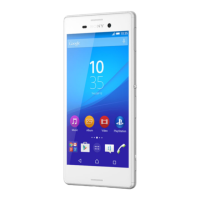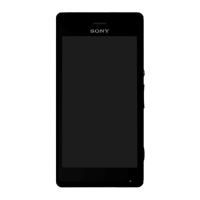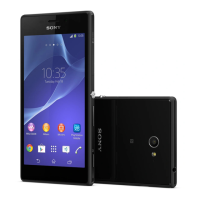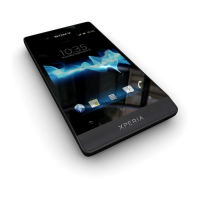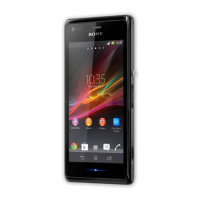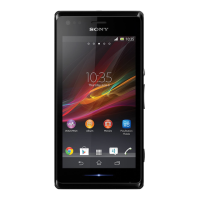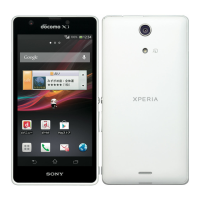Do you have a question about the Sony Xperia M4 Aqua E2303 and is the answer not in the manual?
Introduces the device, its components, and initial setup steps.
Covers touchscreen gestures, screen locking, and home screen navigation.
How to view, launch, move, and uninstall applications.
Browsing the web, Wi-Fi, and mobile data settings.
Sharing mobile data via USB, Bluetooth, or hotspot.
Wireless data sharing and device pairing using NFC and Bluetooth.
Adjusting sound, ringtones, volume, and managing notifications.
Adjusting screen brightness, lock types, and smart backlight control.
Using on-screen keyboards, voice input, and text editing.
Setting device language, date, and time preferences.
Making, receiving, and managing phone calls, including voicemail.
Sending/receiving texts, multimedia messages, and emails.
Adding, editing, organizing, and transferring contacts.
Playing music, listening to radio, and enhancing sound quality.
Taking photos, recording videos, and configuring camera features.
Viewing, editing, sharing, and organizing media files.
Watching videos and using the Movie Creator application.
Using PC Companion/Bridge for device management and software updates.
Finding lost devices and using lockdown modes.
Managing battery life and device performance.
Managing device memory, storage, and data backups.
Diagnostics, restarts, resets, and device protection guidelines.
Introduces the device, its components, and initial setup steps.
Covers touchscreen gestures, screen locking, and home screen navigation.
How to view, launch, move, and uninstall applications.
Browsing the web, Wi-Fi, and mobile data settings.
Sharing mobile data via USB, Bluetooth, or hotspot.
Wireless data sharing and device pairing using NFC and Bluetooth.
Adjusting sound, ringtones, volume, and managing notifications.
Adjusting screen brightness, lock types, and smart backlight control.
Using on-screen keyboards, voice input, and text editing.
Setting device language, date, and time preferences.
Making, receiving, and managing phone calls, including voicemail.
Sending/receiving texts, multimedia messages, and emails.
Adding, editing, organizing, and transferring contacts.
Playing music, listening to radio, and enhancing sound quality.
Taking photos, recording videos, and configuring camera features.
Viewing, editing, sharing, and organizing media files.
Watching videos and using the Movie Creator application.
Using PC Companion/Bridge for device management and software updates.
Finding lost devices and using lockdown modes.
Managing battery life and device performance.
Managing device memory, storage, and data backups.
Diagnostics, restarts, resets, and device protection guidelines.
| Display Size | 5.0 inches |
|---|---|
| Resolution | 720 x 1280 pixels |
| Display Type | IPS LCD |
| Processor | Qualcomm MSM8939 Snapdragon 615 |
| CPU | Octa-core (4x1.5 GHz Cortex-A53 & 4x1.0 GHz Cortex-A53) |
| GPU | Adreno 405 |
| RAM | 2 GB |
| Internal Storage | 8 GB |
| Expandable Storage | microSD, up to 256 GB (dedicated slot) |
| Front Camera | 5 MP |
| Battery Capacity | 2400 mAh |
| Operating System | Android 5.0 (Lollipop), upgradable to 6.0 (Marshmallow) |
| Water Resistance | IP68 dust/water resistant (up to 1.5m for 30 mins) |
| Dimensions | 145.5 x 72.6 x 7.3 mm (5.73 x 2.86 x 0.29 in) |
| Weight | 136 g (4.80 oz) |
| SIM | Nano-SIM |
| Network | GSM / HSPA / LTE |
| Protection | Scratch-resistant glass |
| Loudspeaker | Yes |
| 3.5mm jack | Yes |
| WLAN | Wi-Fi 802.11 a/b/g/n, dual-band, Wi-Fi Direct, DLNA, hotspot |
| Bluetooth | 4.1, A2DP |
| GPS | Yes, with A-GPS, GLONASS |
| NFC | Yes |
| Radio | FM radio |
| USB | microUSB 2.0, USB On-The-Go |
| Sensors | Accelerometer, proximity, compass |
| Rear Camera | 13 MP, f/2.0 |
| Colors | Black, White, Coral |
